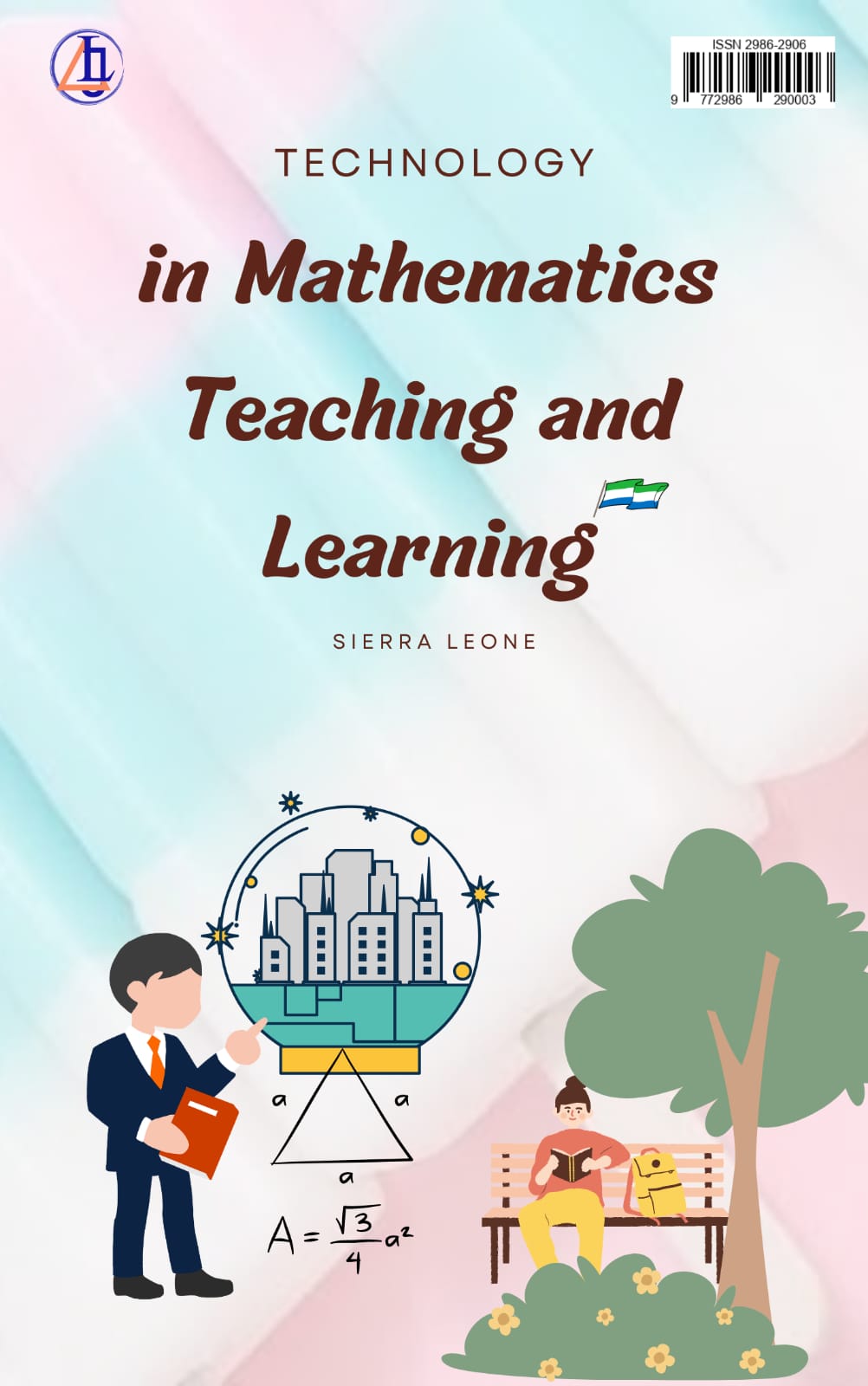Keywords: Impact Evaluation, Mathematics, Technology
Abstract
The analysis is based on a detailed evaluation of primary data collected through case studies, questionnaires, and semi-structured interviews in Senior secondary schools in Masingbi. Mathematics education learning is explored to understand the issues surrounding Technology integration. This study shows that despite the perceived advantages of Technology integrated teaching and learning methods, there are barriers closely connected to teachers’ teaching beliefs at work. Most educators admitted the lack of ongoing professional training programs and curriculum expectations as among the factors that affect their attitudes towards Technology in their respective Teaching and learning schools. Further empirical research is suggested to advance the exploration of the role of subject leaders in Technology -integrated Teaching and learning methods. This research provides an in-depth analysis of the exploration of own practice and mathematics teachers' perceptions on integrating Technology into teaching. The total sample size of respondents was sixty (60), and both simple random sampling technique was used to develop samples of Teachers and Pupils, while a purposive sampling technique was used to develop the sample for the Principals or Heads of Schools of the three selected senior schools in Masingbi as respondents
References
Bossé, M. J., Bayaga, A., Lynch-Davis, K., & ... (2021). Assessing Analytic Geometry Understanding: Van Hiele, SOLO, and Beyond. International Journal for …, 22(1).
Bozkurt, G. (2018). The activity structure of technology-based mathematics lessons: a case study of three teachers in English secondary schools. Research in Mathematics Education, 20(3), 254–272. https://doi.org/10.1080/14794802.2018.1474798
Camacho, A. (2018). Complementing Assessment Processes with Standardized Tests: A Work in Progress. World Academy of Science, Engineering and Technology International Journal of Educational and Pedagogical Sciences, 12(1).
Cankoy, O., & Özder, H. (2017). Generalizability theory research on developing a scoring rubric to assess primary school students’ problem posing skills. Eurasia Journal of Mathematics, Science and Technology Education, 13(6). https://doi.org/10.12973/EURASIA.2017.01233A
Cortés Díaz, H. D., Piáal Ramírez, O. E., Argüelles Cruz, A. J., & Vicario Solórzano, C. M. (2019). Ramath: Mobile Application for Math Learning using Augmented Reality. Research in Computing Science, 148(10), 261–269. https://doi.org/10.13053/rcs-148-10-22
Cortés, J. D. (2021). Innovation for sustainability in the Global South: bibliometric findings from management & business and STEM (science, technology, engineering and mathematics) fields in developing countries. Heliyon, 7(8). https://doi.org/10.1016/j.heliyon.2021.e07809
Darmayanti, R., Sugianto, R., Baiduri, Choirudin, & Wawan. (2022). Digital comic learning media based on character values on students’ critical thinking in solving mathematical problems in terms of learning styles. Al-Jabar: Jurnal Pendidikan Matematika, 13(1), 49–66. http://ejournal.radenintan.ac.id/index.php/al-jabar/index
Dwi Priyo Utomo, Amaliyah, T., Darmayanti, R., Usmiyatun, U., & Choirudin, C. (2023). Students’ Intuitive Thinking Process in Solving Geometry Tasks from the Van Hiele Level. JTAM (Jurnal Teori Dan Aplikasi Matematika), 7(1), 139–149. https://doi.org/10.31764/jtam.v7i1.11528
Fasihi, M., Efimova, O., & Breyer, C. (2019). Techno-economic assessment of CO 2 direct air capture plants. Journal of Cleaner Production, 224. https://doi.org/10.1016/j.jclepro.2019.03.086
Fauza, M. R., Inganah, S., Darmayanti, R., Prasetyo, B. A. M., & Lony, A. (2022). Problem Solving Ability: Strategy Analysis of Working Backwards Based on Polya Steps for Middle School Students YALC Pasuruan. Jurnal Edukasi Matematika Dan Sains), 10(2), 353–363. https://doi.org/10.25273/jems.v10i2.13338
Fernández, E. A., Samacá, L. F., & Martín, C. R. (2021). Diagnose, Analysis, and Proposal of Project Based Learning (PBL): A Case for Analog Communications Course. Proceedings of the LACCEI International Multi-Conference for Engineering, Education and Technology, 2021-July. https://doi.org/10.18687/LACCEI2021.1.1.461
Foshee, C. (2016). Technology-enhanced learning in college mathematics remediation. British Journal of Educational Technology, 47(5), 893–905. https://doi.org/10.1111/bjet.12285
Gamage, S. H. P. W., Ayres, J. R., Behrend, M. B., & Smith, E. J. (2019). Optimising Moodle quizzes for online assessments. International Journal of STEM Education, 6(1). https://doi.org/10.1186/s40594-019-0181-4
Giurgiu, L., & Gligorea, I. (2017). Responsive Web Design Techniques. International Conference KNOWLEDGE-BASED ORGANIZATION, 23(3). https://doi.org/10.1515/kbo-2017-0153
Gudkova, S. A., Yakusheva, T. S., Sherstobitova, A. A., & Burenina, V. I. (2020). Soft Skills Simulation and Assessment: Qualimetric Approach for Smart University. Smart Innovation, Systems and Technologies, 188. https://doi.org/10.1007/978-981-15-5584-8_44
Haviland, S., Robbins, S., Belur, V., Cherfrere, G., & Klieger, D. (2021). Improving Workforce Readiness Skills Among Community College Adult Learners Through New Technologies: Metropolitan Universities, 32(1). https://doi.org/10.18060/23884
Herlina, M., Zulfarina, & Linda, R. (2021). Contextual-Based E-comic Media Design. Proceedings of URICET 2021 - Universitas Riau International Conference on Education Technology 2021. https://doi.org/10.1109/URICET53378.2021.9865903
Hollebrands, K. (2018). Secondary mathematics teachers’ instrumental integration in technology-rich geometry classrooms. Journal of Mathematical Behavior, 49, 82–94. https://doi.org/10.1016/j.jmathb.2017.10.003
In’am, A., Darmayanti, R., Maryanto, B. P. A., Sah, R. W. A., & Rahmah, K. (2023). DEVELOPMENT LEARNING MEDIA E.A.V ON MATHEMATICAL CONNECTION ABILITY OF JUNIOR HIGH SCHOOL. AKSIOMA: Jurnal Program Studi Pendidikan Matematika, 12(1), 573. https://doi.org/10.24127/ajpm.v12i1.6267
Jannah, Z. B., Islahudin, I., & Darmayanti, N. . W. S. (2018). PENGEMBANGAN MODUL FISIKA BILINGUAL MATERI HUKUM NEWTON PADA SISWA SMA KELAS X UNTUK MENINGKATKAN MOTIVASI BELAJAR FISIKA TAHUN AJARAN 2017/2018. ORBITA: Jurnal Kajian, Inovasi Dan Aplikasi Pendidikan Fisika, 4(2). https://doi.org/10.31764/orbita.v4i2.575
Kao, J. C., Rivera, N. M., Clemens, B., & Cai, L. (2018). Validating career-readiness features in high school assessments. National Center for Research on Evaluation, Standards, and Student Testing (CRESST), December.
Kusmaharti, D., & Yustitia, V. (2022). Self-regulated learning-based digital module development to improve students’ critical thinking skills. In Jurnal Pendidikan Matematika (Vol. 13, Issue 1). http://ejournal.radenintan.ac.id/index.php/al-jabar/index
Lau, K. H., Lam, T., Kam, B. H., Nkhoma, M., Richardson, J., & Thomas, S. (2018). The role of textbook learning resources in e-learning: A taxonomic study. Computers and Education, 118. https://doi.org/10.1016/j.compedu.2017.11.005
Laub, J. A. (1999). Assessing the servant organization; Development of the Organizational Leadership Assessment (OLA) model. Dissertation Abstracts International,. Procedia - Social and Behavioral Sciences, 1(2).
Manasikana, A., Anwar, M. S., Setiawan, A., Choirudin, C., & Darmayanti, R. (2023). Eksplorasi Etnomatematika Islamic Center Tulang Bawang Barat. Jurnal Perspektif, 7(1). https://doi.org/10.15575/jp.v7i1.216
Matuk, C. (2021). How Do Teachers Use Comics to Promote Engagement, Equity, and Diversity in Science Classrooms? Research in Science Education, 51(3), 685–732. https://doi.org/10.1007/s11165-018-9814-8
Misfeldt, M. (2016a). Supporting primary-level mathematics teachers’ collaboration in designing and using technology-based scenarios. Journal of Mathematics Teacher Education, 19(2), 227–241. https://doi.org/10.1007/s10857-015-9336-5
Misfeldt, M. (2016b). Supporting primary-level mathematics teachers’ collaboration in designing and using technology-based scenarios. Journal of Mathematics Teacher Education, 19(2), 227–241. https://doi.org/10.1007/s10857-015-9336-5
Muhammad, I., Marina Angraini, L., Darmayanti, R., & Sugianto, R. (2023). Students’ Interest in Learning Mathematics Using Augmented Reality: Rasch Model Analysis. Edutechnium Journal of Educational Technology, 1(1), 89–99. https://www.edutechnium.com/journal
ND Safitri, R Darmayanti, U Usmiyatun, & D Nurmalitasari. (2023). 21st Century Mathematics Learning Challenges: Bibliometric Analysis of Trends and Best Practices in Shinta Indexed Scientific Publications. JEMS: Jurnal Edukasi Matematika Dan Sains, 11(1), 136–152.
Psycharis, G. (2018). Studying the process of becoming a teacher educator in technology-enhanced mathematics. Journal of Mathematics Teacher Education, 21(6), 631–660. https://doi.org/10.1007/s10857-017-9371-5
Rahmah, K., Inganah, S., Darmayanti, R., Sugianto, R., & Ningsih, E. F. (2022). Analysis of Mathematics Problem Solving Ability of Junior High School Students Based on APOS Theory Viewed from the Type of Kolb Learning Style. INdoMATH: Indonesia Mathematics Education, 5(2), 109–122. https://indomath.org/index.php/
Rionanda, L. S., Farida, F., Putra, F. G., Damayanti, E., & Pradana, K. C. (2022). ICT-Based Lajur Bata Game Media Using Guided Discovery Method on Flat-sided Space Geometry Subject. Journal Corner of Education, Linguistics, and Literature, 1(4), 235–248. https://doi.org/10.54012/jcell.v1i4.47
Rizki, N., Laila, A. R. N., Inganah, S., & Darmayanti, R. (2022). Analysis of Mathematic Connection Ability in Mathematics Problem Solving Reviewed from Student’s Self-Confidence. Seminar Nasional Teknologi Pembelajaran, 2(1), 111–126. http://snastep.um.ac.id/pub/index.php/proceeding/indexKeahliandanPerformaPakardalamTeknologiPendidikanuntuk
Saal, L. K., & Shaw, D. M. (2020). Facilitating Civic Learning Within Adult Literacy/Education Curricula. Journal of Adolescent and Adult Literacy, 64(2). https://doi.org/10.1002/jaal.1084
Sah, R. W. A., Laila, A. R. N., Setyawati, A., Darmayanti, R., & Nurmalitasari, D. (2023). Misconception Analysis of Minimum Competency Assessment (AKM) Numeration of High School Students from Field Dependent Cognitive Style. JEMS: Jurnal Edukasi Matematika Dan Sains, 11(1), 58–69. https://doi.org/10.25273/jems.v11i1.14112
Sarifah, I., Rohmaniar, A., Marini, A., Sagita, J., Nuraini, S., Safitri, D., Maksum, A., Suntari, Y., & Sudrajat, A. (2022). Development of Android Based Educational Games to Enhance Elementary School Student Interests in Learning Mathematics. International Journal of Interactive Mobile Technologies, 16(18). https://doi.org/10.3991/ijim.v16i18.32949
Schaufeli, W. B., Desart, S., & De Witte, H. (2020). Burnout assessment tool (Bat)—development, validity, and reliability. International Journal of Environmental Research and Public Health, 17(24). https://doi.org/10.3390/ijerph17249495
Schindelwig, K., Ellensohn, S., Kaps, P., & Nachbauer, W. (2017). Validation of a three-dimensional finite element model of flex-pole impacts. Proceedings of the Institution of Mechanical Engineers, Part P: Journal of Sports Engineering and Technology, 231(4). https://doi.org/10.1177/1754337117700260
Sekaryanti, R., Cholily, Y. M., Darmayanti, R., Rahma, K., Prasetyo, B., & Maryanto, A. (2022). Analysis of Written Mathematics Communication Skills in Solving Solo Taxonomy Assisted Problems. Jurnal Edukasi Matematika Dan Sains, 10(2), 395–403. https://doi.org/10.25273/jems.v10i2.13707
Senán-Salinas, J., Landaburu-Aguirre, J., Contreras-Martinez, J., & García-Calvo, E. (2022). Life Cycle Assessment application for emerging membrane recycling technologies: From reverse osmosis into forward osmosis. Resources, Conservation and Recycling, 179. https://doi.org/10.1016/j.resconrec.2021.106075
Sugianto, R., Darmayanti, R., Aprilani, D., Amany, L., Rachmawati, L. N., Hasanah, S. N., & Aji, F. B. (2017). Experiment on Ability to Understand Three-Dimensional Material Concepts Related to Learning Styles Using the Geogebra-Supported STAD Learning Model Abstra ct. Al-Jabar: Jurnal Pendidikan Matematika, 8(2), 205–212.
Sugianto, R., Darmayanti, R., Wahyu Arian Sah, R., & Usmiyatun, U. (2023). Bulletin of Educational Management and Innovation Word square English learning media design assisted by the Canva application. Bulletin of Educational Management and Innovation, 1(1), 1–16. https://journal.rafandhapress.com/BEMI
Tackett, S., Green, D., Dyal, M., O’Keefe, E., Thomas, T. E., Nguyen, T., Vo, D., Patel, M., Murdock, C. J., Wolfe, E. M., & Shehadeh, L. A. (2021). Use of commercially produced medical education videos in a cardiovascular curriculum: Multiple cohort study. JMIR Medical Education, 7(4). https://doi.org/10.2196/27441
Tan, C. (2017). Information technology, mathematics achievement and educational equity in developed economies. Educational Studies, 43(4), 371–390. https://doi.org/10.1080/03055698.2016.1277137
Tarrés, M. A., & Cullell, I. F. (2021). Playing or learning? Playful learning in teacher’s musical training. Revista Electronica Complutense de Investigacion En Educacion Musical, 18. https://doi.org/10.5209/RECIEM.67853
Urrutia, F. Z., Loyola, C. C., & Marín, M. H. (2019). A tangible user interface to facilitate learning of trigonometry. International Journal of Emerging Technologies in Learning, 14(23). https://doi.org/10.3991/ijet.v14i23.11433
Vanden Eng, J. L., Chan, A., Abílio, A. P., Wolkon, A., Ponce De Leon, G., Gimnig, J., & Morgan, J. (2015). Bed net durability assessments: Exploring a composite measure of net damage. PLoS ONE, 10(6). https://doi.org/10.1371/journal.pone.0128499
Wawan, W., Marsigit, M., Fitria Ningsih, E., Widyawati, S., Kusumaningtyas, W., Mahmudi, M., Suhono, S., Mukhlishin, A., Ganda Putra, F., & Setiawan, A. (2018). Technology-Integrated Collaborative Learning: Convenient Alternative in Developing the Problem Solving Capability and Positive Attitude towards Mathematics. International Journal of Engineering & Technology, 7(3.2), 737. https://doi.org/10.14419/ijet.v7i3.2.18739
Weber, K. (2021). Connecting Research to Teaching: Teaching Trigonometric Functions: Lessons Learned from Research. The Mathematics Teacher, 102(2). https://doi.org/10.5951/mt.102.2.0144
Wong, S. L. (2019). Relationship between interest and mathematics performance in a technology-enhanced learning context in Malaysia. Research and Practice in Technology Enhanced Learning, 14(1). https://doi.org/10.1186/s41039-019-0114-3
Wulandari, T., Nurmalitasari, D., Susanto, K., Darmayanti, R., & Choirudin. (2022). Etnomatematika Pada Batik Daun Sirih dan Burung Kepodang Khas Pasuruan. Seminar Nasional Teknologi Pembelajaran, 2(1), 95–103. http://snastep.um.ac.id/pub/index.php/proceeding/index
Yalley, E., Armah, G., & Ansah, R. K. (2021). Effect of the VAN Hiele Instructional Model on Students’ Achievement in Geometry. Education Research International, 2021. https://doi.org/10.1155/2021/6993668
Yim, M., & Gomez, R. (2021). Strengthening ICT4D evaluation: lessons from the fields of program evaluation, IS/IT evaluation, and aid/development evaluation. Information Technology for Development, 27(2). https://doi.org/10.1080/02681102.2021.1876619
Zaika, A. (2020). Forming Digital Literacy in Students Based on the Experience of EU Countries. Comparative Professional Pedagogy, 9(4). https://doi.org/10.2478/rpp-2019-0039
Zamora, L. P. (2021). Production of Comics in POWTOON as a Teaching-Learning Strategy in an Operations Research Course. European Journal of Contemporary Education, 10(1), 137–147. https://doi.org/10.13187/ejced.2021.1.137

Downloads
Published
How to Cite
Issue
Section
License
Copyright (c) 2023 Samuel Karim, Exton Mohamed Zoker

This work is licensed under a Creative Commons Attribution-ShareAlike 4.0 International License.


 https://doi.org/10.61650/alj.v1i2.63
https://doi.org/10.61650/alj.v1i2.63





